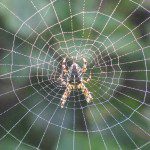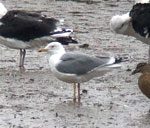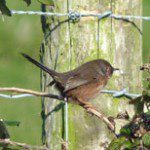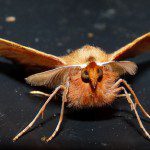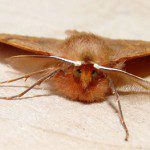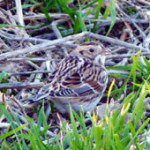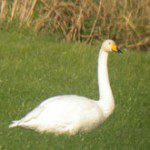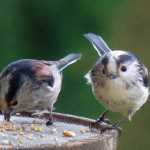NB: The following is reproduced by kind permission of Axe Estuary Birds. Full credit goes to the team that produces the newsletter (see the bottom of the post for specific details). Photographs are credited throughout the text although we are working to preserve the original layout wherever possible in the future.
The Birds
With the departure of the Solitary Sandpiper on the evening of Friday 15th, it was back to normality for the patch.
Unprecedented numbers of Lapland Buntings have invaded the UK this autumn – and they arrived much earlier than usual too. So on 24th, two at Axe Cliff, and the following day, one or two on Beer Head weren’t much of a surprise – but they were much appreciated. All were hard to see and only showed briefly, except for one of the Axe Cliff birds that was ‘hunted down’ in the evening.
There were a couple more passerine highlights during this period too, with two Woodlark west over Beer on 22nd, and two Hawfinch that flew off north from Axmouth on 27th.
A couple of Black Redstarts have been seen, and Firecrest have been reported from Jubilee Gardens in Beer (two on 25th) and another on Beer Head on 27th. A Dartford Warbler on Beer Head on 25th was the first record of the year for this species on patch. To complete the Beer Head sightings for this newsletter, a Merlin has been seen on two dates here.
Now to larger birds! Whooper Swans seem to be becoming a regular winter visitor to this Estuary now; an adult was found amongst the Mute Swans opposite Stedcombe Vale on 24th and is still present at time of writing this.
An adult Yellow-legged Gull on the Estuary on 26th arrived with a big influx of Great Black-backed Gulls; 385 were counted on one ‘sweep’ of the river and marshes. Three Mediterranean Gulls were noted on 29th.
Photos: Lapland Bunting, Dartford Warbler and Yellow-legged Gull – Gavin Haig; Whooper Swan – Steve Waite.
Ringing
18th October. A good morning’s effort with 36 birds as follows:
Robin 3; Reed Bunting 4; Dunnock 7(1); Blackbird 2; House Sparrow 2(1); Long-tailed Tit 13(1); Song Thrush 1; Goldcrest 1; Treecreeper 1; Blue Tit 1; and Wren 1.
News from the Reserves
Seaton Marshes is in the process of being flooded, it will probably take about a week. In the mean time the hide is still accessible.
Black Hole Marsh. The hide is now nearly finished, all it needs now is for the paint to dry, so it should be open by Monday Nov 1st – and very good it is too, well worth a visit.
Colyford Common. The extension to the hide is now nearly complete, and so is the ramp. It feels more than twice the size of the original. It will be open to the public towards the end of the week. If you plan to go to the “Birds for Beginners” on Thursday 4th November, please check with Countryside Service on 01395 517557, or James Chubb on 0773456 8985, in case the paint is not dry!
Holyford Woods. On the wonderful sunny and still days we have had recently, the Woods have been so peaceful and glowing with the autumn colours of the beech leaves. This morning there was a heavy frost, sparkling in the sun. There are places to sit other than on my seat, and from a log down in the valley I finally located the nest of the Hornets I have seen around over the last three months, hidden in a tangle of holly and bracken. Paco poking his nose in disturbed them, but they were not at all aggressive. Since the bracken was cut in the field at the Holyford end, the Green Woodpeckers are regularly feeding on the ants. From a tree stump on The Hangings I was able to do a proper count of 15 Long tailed Tits, as they flew from the valley up to the trees at the West end of the hill. Twice I have seen the Roe buck in a patch of sunlight feeding among the brambles at the West end of The Hangings, and also the white bottoms of two Roe does vanishing into the trees. It is still not wise for walkers to let dogs inspect the Badger setts, in case a mangy Fox is around, as the local population is infected, with one having been released from its agony. (Jean Kreiseler)
The Trivia
Peter Vernon thought we might like to see a couple of images of one of the ‘nicer’ (well he thinks it’s nice!) moths that are about at the moment, it is a Feathered Thorn Moth and gets it’s name from the males feathery antennae. He caught this one recently in his Moth trap.
These Long Tailed Tits, also by Peter qualify as “cute”!
And this spider’s web, by Sue Smith, is worth sharing too.
Lee Murley, sadly, found a dead Barn Owl on the A3052 near Boshill Cross on 29th October. Possibly the one that has been seen frequently at Black Hole Marsh recently.
Diary Dates
Thursday 4th November 10am to 12 Noon Meet the Birds at Colyford Common.
Please check before you go, see above.
Saturday 6th November 9.00am Birds from the tram with Don Cotton.
Sunday 21st November 9.00am Birds from the tram with Donald Campbell.
Thursday 27th November 10am to 12 Noon Meet the Birds at Seaton Marshes.
This twice-monthly email newsletter is freely available to anyone who would like it, as is a periodic one about the activities of the East Devon Local Group of the Devon Wildlife Trust. Just send me an email with Axe Estuary Birds and/or East Devon DWT in the subject line. Also, for those without a computer, I will send a copy by post if you would like to send me some stamps.
Thanks to those who keep me informed – please continue to tell us of any unusual, interesting or amusing sightings, and what is about locally, and send any photos you would like to share.
Steve, Mike, Jean and David. davidwalters@eclipse.co.uk. tel. 01297 552616 Mobile 0779 1541 744.

